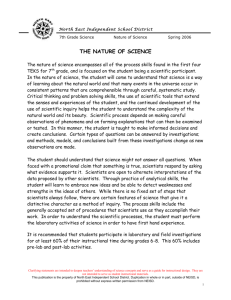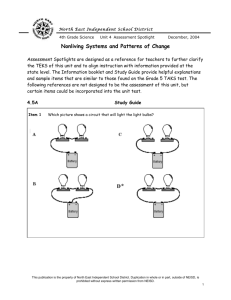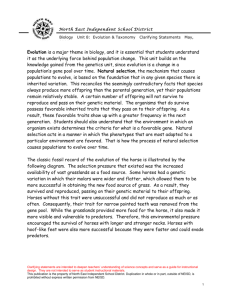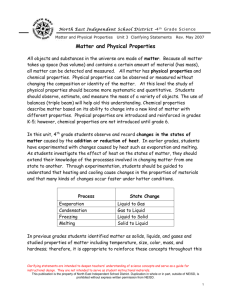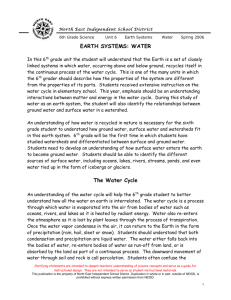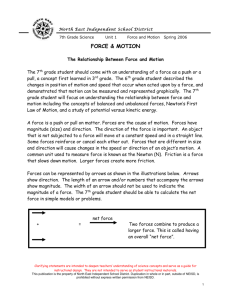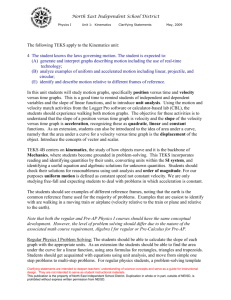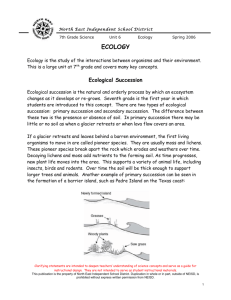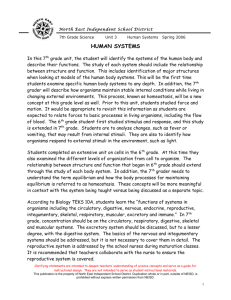7th grade Chemistry - North East Independent School District
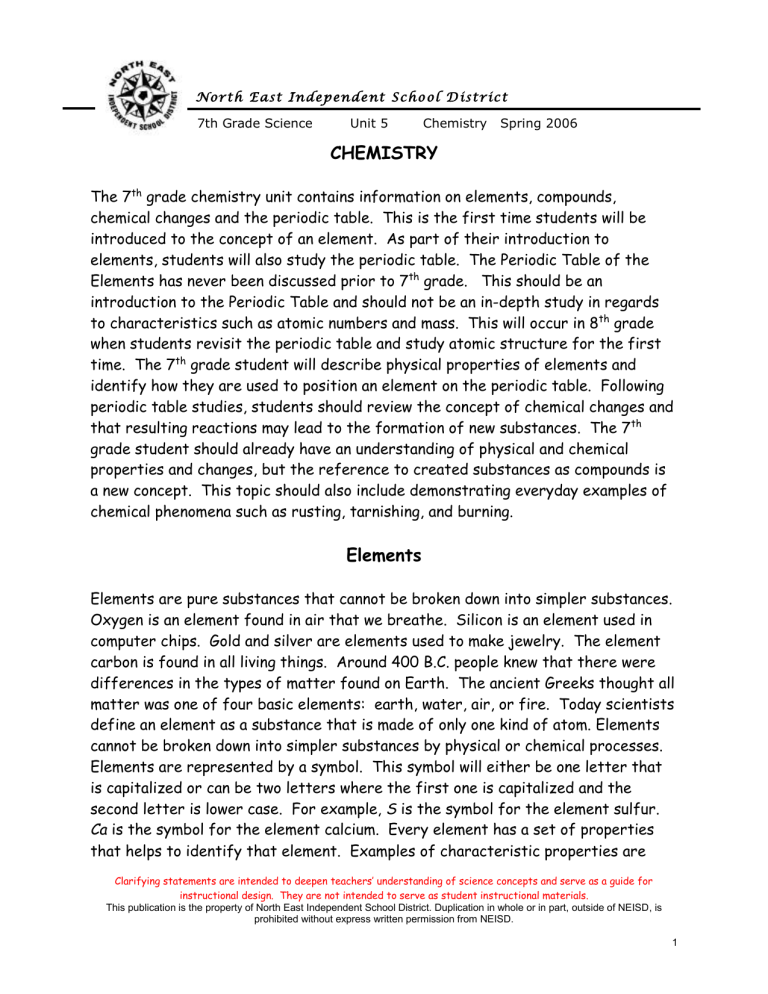
North East Independent School District
7th Grade Science Unit 5 Chemistry Spring 2006
CHEMISTRY
The 7 th grade chemistry unit contains information on elements, compounds, chemical changes and the periodic table. This is the first time students will be introduced to the concept of an element. As part of their introduction to elements, students will also study the periodic table. The Periodic Table of the
Elements has never been discussed prior to 7 th grade. This should be an introduction to the Periodic Table and should not be an in-depth study in regards to characteristics such as atomic numbers and mass. This will occur in 8 th grade when students revisit the periodic table and study atomic structure for the first time. The 7 th grade student will describe physical properties of elements and identify how they are used to position an element on the periodic table. Following periodic table studies, students should review the concept of chemical changes and that resulting reactions may lead to the formation of new substances. The 7 th grade student should already have an understanding of physical and chemical properties and changes, but the reference to created substances as compounds is a new concept. This topic should also include demonstrating everyday examples of chemical phenomena such as rusting, tarnishing, and burning.
Elements
Elements are pure substances that cannot be broken down into simpler substances.
Oxygen is an element found in air that we breathe. Silicon is an element used in computer chips. Gold and silver are elements used to make jewelry. The element carbon is found in all living things. Around 400 B.C. people knew that there were differences in the types of matter found on Earth. The ancient Greeks thought all matter was one of four basic elements: earth, water, air, or fire. Today scientists define an element as a substance that is made of only one kind of atom. Elements cannot be broken down into simpler substances by physical or chemical processes.
Elements are represented by a symbol. This symbol will either be one letter that is capitalized or can be two letters where the first one is capitalized and the second letter is lower case. For example, S is the symbol for the element sulfur.
Ca is the symbol for the element calcium. Every element has a set of properties that helps to identify that element. Examples of characteristic properties are
Clarifying statements are intended to deepen teachers’ understanding of science concepts and serve as a guide for instructional design. They are not intended to serve as student instructional materials.
This publication is the property of North East Independent School District. Duplication in whole or in part, outside of NEISD, is prohibited without express written permission from NEISD.
1
North East Independent School District
7th Grade Science Unit 5 Chemistry Spring 2006 density, state of matter at room temperature, and reactivity with oxygen or acids.
The chart below provides an example of how elements may share some properties but have others that differ:
Gold (Au) metal solid at room temperature nonreactive with oxygen melting point: 1064 o C malleable conducts electricity
Comparison of 3 Elements
Iron (Fe) metal solid at room temperature reacts with oxygen melting point: 1538 o C brittle when pure conducts electricity
Aluminum (Al) metal solid at room temperature reacts with oxygen melting point: 962 o C malleable conducts electricity
Students should be given an inquiry-based activity in which they sort elements according to their properties. This could lead to an introduction of the periodic table and how it is organized.
The Periodic Table of the Elements
Scientists tried to organize the elements as more and more of them were discovered. In the mid-1800’s, a scientist named Dmitri Mendeleev listed all the known elements (about 63 at the time) according to their properties and organized them into rows and columns. Today there are over 110 elements. Some are found in nature and others have been created in scientific laboratories. On the modern periodic table, elements are still organized into rows and columns according to their properties. The elements in a column, referred to as a group, have certain properties that they share. A row of elements is referred to as a period.
It is recommended that students practice using the periodic table provided on the
TAKS formula chart for middle school science. Tables that group elements according to colors change with each textbook and will not be utilized at all on the
TAKS test. The TAKS periodic table can be accessed on page 15 of the information booklet with the following link: http://www.tea.state.tx.us/student.assessment/taks/booklets/science/g8e.pdf
.
A copy of the table is also provided on the following page:
Clarifying statements are intended to deepen teachers’ understanding of science concepts and serve as a guide for instructional design. They are not intended to serve as student instructional materials.
This publication is the property of North East Independent School District. Duplication in whole or in part, outside of NEISD, is prohibited without express written permission from NEISD.
2
North East Independent School District
7th Grade Science Unit 5 Chemistry Spring 2006
Clarifying statements are intended to deepen teachers’ understanding of science concepts and serve as a guide for instructional design. They are not intended to serve as student instructional materials.
This publication is the property of North East Independent School District. Duplication in whole or in part, outside of NEISD, is prohibited without express written permission from NEISD.
3
North East Independent School District
7th Grade Science Unit 5 Chemistry Spring 2006
Each square on the periodic table contains information specific to that element.
The following is the key from the table used on the TAKS formula chart, illustrating how this information is provided for students to use and interpret:
Elements can be classified into three major categories: metals, non-metals and metalloids. The zig-zag (stair-step) line on the periodic table separates the metals from the non-metals. Six of the elements that border this line are the metalloids.
The 7 th grade student needs to know the properties of metals, non-metals and metalloids.
Clarifying statements are intended to deepen teachers’ understanding of science concepts and serve as a guide for instructional design. They are not intended to serve as student instructional materials.
This publication is the property of North East Independent School District. Duplication in whole or in part, outside of NEISD, is prohibited without express written permission from NEISD.
4
North East Independent School District
7th Grade Science Unit 5 Chemistry Spring 2006
Other organizational trends of the periodic table should also be noted by students.
Examination of the elements within periods shows that the atomic number increases from left to right. Physical and chemical properties such as conductivity and reactivity change from left to right. The vertical column groups contain elements that are closely related. These elements have many similar physical and chemical properties. When students examine forms of the periodic table that differ from the appearance of the one used by TAKS (such as the textbook version), they may notice the state of matter of the element is also noted.
Students should know that if an element is listed as a solid, liquid or gas on the table, this is its state at room temperature. Elements # 58-71 and elements #90-
103 are usually shown below the rest of the periodic table. Most of these elements are man-made and/or radioactive. They are placed below the table to save space and allow the table to fit on one page.
Clarifying statements are intended to deepen teachers’ understanding of science concepts and serve as a guide for instructional design. They are not intended to serve as student instructional materials.
This publication is the property of North East Independent School District. Duplication in whole or in part, outside of NEISD, is prohibited without express written permission from NEISD.
5
North East Independent School District
7th Grade Science Unit 5 Chemistry Spring 2006
Chemical Phenomena
A chemical property of matter describes its ability to react with other substances.
Examples of chemical properties are flammability, reactivity with an acid, reactivity with oxygen, reactivity with water, etc. Students should be familiar with the formation of rust and tarnish as examples of chemical changes. Rust, or iron oxide, is a new substance that has formed from a reaction between iron and oxygen. This new product has different properties than the reactants that formed it. Students should also learn what tarnish means. Many students wear silver jewelry. Silver tarnishes when it is exposed to moisture or the reaction between silver and sulfur in the air.
The following is a list of possible evidence that a chemical change or reaction has occurred between substances:
gases formed or bubbles seen
color and/or odor change (sometimes)
two or more liquids combine to form a liquid and a solid (a precipitate)
burning with smoke being produced
rust or tarnish forms
sound production
Compounds
When a chemical reaction occurs, the arrangement of the atoms of the elements are changed and a new substance is created. This new substance is a compound.
Students should recognize that compounds are composed of elements.
A compound is a substance that is made up of atoms of more than one element that are chemically combined. The compound has properties that are different from the elements that make up the compound.
Compounds are always made of the same elements in the same proportion. A formula is used to represent the ratio of each element in a compound. One example would be carbon dioxide (CO
2) and carbon monoxide (CO). Both compounds are formed from carbon and oxygen. It is the formula and their properties that
Clarifying statements are intended to deepen teachers’ understanding of science concepts and serve as a guide for instructional design. They are not intended to serve as student instructional materials.
This publication is the property of North East Independent School District. Duplication in whole or in part, outside of NEISD, is prohibited without express written permission from NEISD.
6
North East Independent School District
7th Grade Science Unit 5 Chemistry Spring 2006 allow them to be identified. Carbon dioxide (CO
2
) is a gas found in drinks such as cola and will cause the drink to fizz. Carbon monoxide (CO) is a poisonous gas that has no odor. The formula for water is H
2
0, and the formula for hydrogen peroxide is H
2
0
2
. Hydrogen peroxide is a liquid that can be bought at the drug store and is used to pour on a cut to help clean it. If, however, water and hydrogen peroxide were placed side-by-side, both would look like clear, odorless liquids. Table salt is made up of the elements sodium and chlorine. Table salt (NaCl) is a compound made up of a green-yellowish poisonous gas (chlorine) and a silvery metal that is extremely explosive (sodium). Together they combine to create a white salt that people use to season their food. This is a good example of how the properties of compounds differ from the properties of the elements they are made of.
According to the 2005 TAKS information booklet, “students should be able to recognize the elements that make up common compounds, such as water, sugar and salt.” The following table lists some elements and formulas students should learn to recognize:
Compound Formula Elements in Compound water sugar (glucose) table salt carbon dioxide
H
2
0
C
6
H
12
O
6
NaCl
CO
2 hydrogen and oxygen carbon, hydrogen and oxygen sodium and chlorine carbon and oxygen
Clarifying statements are intended to deepen teachers’ understanding of science concepts and serve as a guide for instructional design. They are not intended to serve as student instructional materials.
This publication is the property of North East Independent School District. Duplication in whole or in part, outside of NEISD, is prohibited without express written permission from NEISD.
7
North East Independent School District
7th Grade Science Unit 5 Chemistry Spring 2006
Symbols and models can be used to represent elements and compounds. The following is an example of how diagrams can used as models of elements and compounds:
hydrogen sodium carbon chlorine oxygen
water sodium chloride carbon monoxide
Students should understand that when elements or substances are put together, they do not always bond to form a compound or new substance. When this happens they retain their own properties and are referred to as a mixture. A characteristic of mixtures is that they can usually be easily separated back into their original parts by physical means. An example of a mixture would be sugar in water. Both sugar and water are compounds. When they are mixed together, however, they do not bond and they can easily be separated again by evaporation.
Clarifying statements are intended to deepen teachers’ understanding of science concepts and serve as a guide for instructional design. They are not intended to serve as student instructional materials.
This publication is the property of North East Independent School District. Duplication in whole or in part, outside of NEISD, is prohibited without express written permission from NEISD.
8
